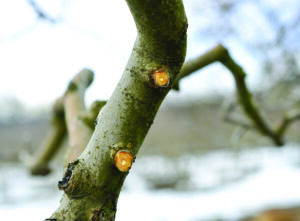
March is the perfect time to prune back trees and shrubs before the growing season begins.
March is here, and this month we begin the transition from winter to spring.
It’s nature’s rejuvenation, it’s when we start to see our landscapes begin to come alive with early blooms, budding trees and the first signs of the grass beginning to green-up and grow.
Let’s begin by discussing fertilizers, because generally speaking, the time for the first application of fertilizer is four to six weeks before plant growth begins in the spring, which means now!
To be all they can be, plants need 17 essential nutrients, most of which are secondary and trace nutrients. The three major plant nutrients, nitrogen, phosphorus and potassium, are considered the most important because of the large amounts of each element utilized by plants.
Nitrogen is important for foliar growth, as it is a major component of chlorophyll, the compound by which plants use the suns energy to produce sugars from water and carbon dioxide, also known as photosynthesis.
It is also an important component of amino acids, which are the building blocks of proteins needed for plant growth.
Phosphorus is needed for healthy root systems and flower development, and plays a key role in photosynthesis for the metabolism of sugars, energy transfer and storage, cell division and enlargement.
It also increases water use efficiency, improves the efficiency of other nutrients, especially nitrogen, and contributes to disease resistance.
It also helps plants cope with cold temperatures as well as moisture stress and plant maturity.
Potassium helps with the plants vigor and overall health, and helps plants fight against disease.
Potassium regulates leaf transpiration, which is the plants version of breathing.
It is where water and oxygen in the plant are released into the air and carbon dioxide is taken in by the plant.
Natural organic fertilizers have a positive effect on soil micro-organisms and beneficial earthworms, which improves soil structure and aeration.
Natural organics break down gradually, depending on the amount of moisture, temperatures and microbial activity in the soil.
The nutrients in organic fertilizers become available over an extended period of time, which helps in preventing fertilizer run-off.
This keeps your plants healthy and green and the Chesapeake Bay clean!
We recommend and sale only the tone Espoma products.
They are 100-percent natural and organic approved.
They are safe for people, pets and the environment.
All products in the Tone Family are enhanced with Bio-tone beneficial microbes, plus Mycorrhizae, which helps plants establish fast, develop deeper roots, and have superior blooms.
All Espoma products are made in a state-of-the-art manufacturing facility, which guarantees consistency, and quality, while using only the finest natural and organic ingredients, never are any sludges or fillers ever used.
It is a good idea to consider spraying all deciduous trees and shrubs with a dormant spray mixture.
Pick a day in which air temperatures will remain above 40 degrees for a 24-hour period. Be sure to use a sprayer that has not been used for killing weeds, as the any residuals could damage your plants.
Mix together in the sprayer one ounce of both horticultural oil and one ounce of liquid copper to a gallon of water.
Spray the trees and shrubs until you see dripping off the branches.
This is very important to do this for Crape Myrtles, since the scale problems on these plants was very wide-spread last year.
March is the perfect time to prune back trees and shrubs before the growing season begins.
Remember do not prune spring flowering shrubs as you will cut off the flowers!
Most flowering plants need to be pruned after they are finished blooming for the season.
Never prune more than one-third of the total plant mass, and prune away any branches that are growing inward, are week or diseased, and anything growing below 10 and 2 o’clock, because they are more easily broken in the wind.
If you have questions about pruning come by and we will help you.
(Editor’s Note: Ken Morgan is the owner of Robin’s Nest Floral and Garden Center in Easton, Md.)




